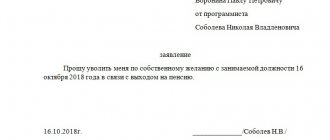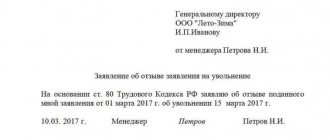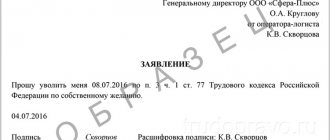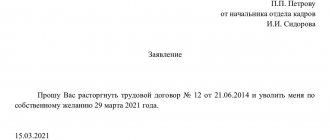Is it possible to fire retroactively?
If we turn to the labor code, it is not possible to dismiss an employee retroactively; such dismissal is a direct violation of the employee’s rights, and therefore he has every right to go to court. However, there are situations that are specified separately in legislative acts.
For example, an employee is absent from his work month for quite a long time, or rather 6 months. The employer makes a decision on dismissal. How to fire an employee in this case? There is no need to dismiss for absenteeism in such a situation, due to the fact that the reason why the employee is absent for so long may be valid. And if the real circumstances of the employee’s absence are clarified, it is possible that he will have to be dismissed under another article. What should the employer do in this case:
- The first step is to issue a reprimand to the employee for systematically violating the terms of the employment contract;
- After this, the employer has the right not to accrue wages to such an employee;
- During the employee’s absence, the employer has the right to hire another employee by concluding a fixed-term agreement with him;
- Then the employer must apply to the court to declare the employee missing;
- By a court decision, an employee can be dismissed (83 Labor Code of the Russian Federation);
- If the employee is wanted and the reason for his absence is not valid, he is fired for absenteeism. The employee is fired from the moment he is reprimanded.
Can a person be legally fired from work in this way?
According to the law, it is impossible to terminate a contract with an employee on a previous date, since in this case the procedure is violated, which includes the stages:
- Advance warning to the other party about leaving.
- Familiarization with the order and its signing on the day of dismissal.
- Issuance of working documentation and payment on the last working day.
As a result, the employee has the right to go to court, challenge the dismissal and be reinstated in his position.
However, in some cases, termination of the contract by a previous date is allowed . In this case, the employer must follow a strict procedure for completing the procedure. For example, an employee does not show up for work for 7 months. He does not inform his employer about his resignation; it is impossible to reach him by phone.
It is impossible to fire a person for absenteeism in such a situation, since there is no explanation from the employee regarding his absence - that is, the reason may be valid.
The employer should follow the following algorithm:
- Issue a reprimand to the absent employee for systematic violation of the terms of the contract and work discipline.
- After this, it is permissible to stop accruing wages.
- To perform the duties of an employee, it is allowed to hire another person by signing a fixed-term contract with him.
- Next comes an application to the court to declare the person missing.
- After the judge makes an appropriate decision, it is permissible to dismiss a citizen under Art. 83 of the Labor Code of the Russian Federation “retroactively” - on the day of the reprimand.
This method of dismissal is completely legal and cannot be challenged.
If a person dies, the contract is also terminated under Art. 83 of the Labor Code of the Russian Federation, while the documentation can be completed on a previous date if the employer learned about the incident later. The day of dismissal sets the official date of death.
It is possible to terminate the working relationship “retrospectively” for absenteeism. If the employee’s guilt is proven and a violation is recorded, it is possible to terminate the contract on the day of his last visit to work.
Often, “retroactive” dismissal is carried out in other cases, in the absence of an objective need for it:
- At the discretion of the employee. The person himself expresses a desire to leave early, which is indicated in the application.
- By agreement of the parties. The employer and employee prescribe the conditions for terminating the employment relationship, and the date may be entered as past.
However, in this case, the employer must be prepared for the employee to challenge the dismissal in court. The standard procedure for terminating a contract is considered violated, so the court will take the employee’s side, even if there is a mutual agreement in the concluded agreement.
Employer's liability
If an employee is dismissed retroactively, the employer faces liability for (5.27 Code of Administrative Offenses of the Russian Federation). Responsibility is provided due to the fact that the employer violated the wording of the entry in the employee’s employment record. The fine will be as follows:
- 1000 – 5000 rubles for an official;
- 1000 – 5000 rubles for an entrepreneur, and the court may impose a ban on carrying out activities for up to 3 months;
- 30,000 – 50,000 rubles for a legal entity, as well as a ban on conducting activities for up to 3 months.
In case of repeated violation, the employer also faces a ban on employment for 1 to 3 years.
Basic provisions
Read: What to do if your employer forces you to resign?
The rules and procedure for terminating employment contracts are set out in Chapter. 13 Labor Code of the Russian Federation. The law strictly regulates in what cases this is possible:
- This can happen if both parties have reached a mutual agreement;
- Provided that the contract has expired;
- The employee has the right to take the initiative by writing a statement of his own free will;
- The initiative comes from the employer. So they can be fired for failure to fulfill their duties, for absenteeism, etc.;
- Refusal by an employee due to changed terms of the employment contract, etc.
There are eleven such reasons in total. In addition, the Code clearly establishes a time frame for all actions related to dismissal. This is a mandatory period allotted for filing an application, providing a calculation, etc. Depending on the type of employment contract, these time frames may vary. So, if an employee is registered on a permanent basis and wants to resign, then he is obliged to notify the employer 2 weeks before the planned event.
It is possible not to comply with these restrictions if the employment contract is terminated by agreement of the parties, who themselves set the deadlines for filing an application, working out, etc.
But for none of the categories in the Labor Code does the possibility of dismissing an employee retroactively be provided. And since it is not regulated, it is a violation of the law.
Possible punishment
Read: Disciplinary sanctions, their types and procedure for application
An act such as retroactive dismissal should be considered a violation of labor legislation. The main possible measures of liability for it are defined in Art. 5.27 of the Code of Administrative Offenses of the Russian Federation, which provides:
- Officials will be fined up to 5 thousand rubles.
- Individual entrepreneurs will also be fined up to 5 thousand rubles.
- The organization will pay up to 50 thousand rubles.
If it is discovered that a person commits an offense repeatedly, the penalties will be as follows:
- The official will be fined up to 20 thousand rubles. rub. In some cases, he faces disqualification for up to 3 years.
- For individual entrepreneurs, a fine of up to 20 thousand rubles is provided.
- Organizations will have to pay up to 70 thousand rubles as a fine.
In this case, both the court and the labor inspectorate can determine the punishment.
What to do if you need to formalize your dismissal retroactively
Litigation for illegal dismissal lasts quite a long time and any company does not want to get involved in it. In this regard, employers try to issue it retroactively, but by agreement with the employee. Such dismissal has no actual justification from a legislative point of view, but companies often use it.
The disadvantage of such a dismissal is that the employer will always be found guilty of this dismissal. Of course, if the employee goes to court, but no one is immune from this. Therefore, it is worth finding the grounds that are provided for by law and terminating the contract with current dates, although this is a troublesome task. When going to court, the employer’s behavior may be considered as misleading a third party, since the actual date of dismissal is distorted.
Grounds for retroactive dismissal
- At the initiative of the employee. In this case, the employee writes a statement indicating the required date. The dismissal documents date from the same date;
- Agreement between employee and employer. In this case, not only the desired date of dismissal is indicated, but also the actual date of termination of work;
- Employer initiative. You can also fire an employee for absenteeism. To do this, it is necessary to record all absenteeism. It should be remembered that absenteeism is a gross violation of labor discipline, which leads to unilateral dismissal. The contract is terminated by the date on which the employee last visited his workplace. The corresponding wording should also be included in the labor contract. If the employer simply notifies the employee of the dismissal retroactively, then this is an offense that is grounds for going to court;
- Death of an employee. When the fact of death is established, the termination of the contract with the employee is formalized by an order indicating the actual date. In the employment record, the date of dismissal is indicated according to the actual date of death. The death certificate is indicated as the basis for termination of the contract.
Situations in practice
Organizations of any form of ownership sooner or later are faced with the preparation of documents on the dismissal of an employee. The ideal option to avoid consequences is to design with the current date. With a competent approach to the situation, it will be possible to avoid wage payments, compensation and court proceedings.
Own wish
There are situations when an employee does not come to work for several days without a good reason.
He understands that an entry in the work book may interfere with his further employment. Then the employee comes to the manager with a question about whether it is possible to write a letter of resignation retroactively. Most employers accommodate employees halfway and agree to violate labor laws. To resign retroactively at your own request:
- Days of absenteeism are documented as regular or administrative leave.
- The employee writes a letter of resignation on the required date, taking into account or without working hours.
- The HR department employee enters information into the order and work book on the same date.
When dismissing by agreement of the parties, the actual date of drawing up documents on termination of the contract is also indicated.
Employer initiative
Not all employers know whether it is possible to retroactively fire an employee for absenteeism. This is possible, since unexplained absence from the workplace is a gross violation of discipline. In this case, the fact of absence must be documented in the form of an act or entry in the time sheet.
In case of retroactive dismissal for absenteeism:
- it is necessary to make an appropriate entry in the work book;
- issue an order, it is allowed to use the actual number of paperwork;
- The date of termination of the employment contract is considered to be the last working day when the employee was present at the workplace.
There is no need to rush when filing for dismissal for absenteeism. It is necessary to find out the true reason for the employee’s absence. He can issue a sick leave certificate, leave the city in connection with the funeral of a close relative, be unconscious in the hospital after an accident, and more.
When an employee does not come to work, does not answer phone calls, or the phone is turned off, it is necessary to draw up an act or reprimand for violation of internal regulations . It will allow you to suspend wages and formalize a temporary employment relationship with another person.
The person responsible for the time sheet must go to the employee’s registration and actual residence addresses to find out his whereabouts. In cases where it has not been established, it is necessary, if possible, to contact relatives and report the disappearance to the police.
When search efforts do not produce results, the case is sent to court to declare the person missing. By decision of the court, the employer draws up documents for dismissal. If the wanted person is found and cannot provide proof of valid reasons, he is fired on the day of drawing up an act of violation of internal labor regulations.
The most unpleasant moment is filing a dismissal due to the death of an employee.
The order is issued on the actual date on which the relatives provided the death certificate. In the work book, the date of termination of the employment contract is the date of death , and the reason is the certificate number. It is issued against the signature of a close relative for presentation at the place of request. This is the only situation where labor legislation allows retroactive dismissal.
What date to retroactively dismiss?
Depending on the basis for the dismissal of the employee, the corresponding date is set retroactively:
- The employee’s desire is to put the same date on the work record as in the order;
- Agreement of the parties - the date agreed upon by the employee and the employer;
- Absenteeism – the date on which the employee worked for the last day is indicated, and it is necessary to refer to a gross violation of labor regulations;
- Death - the work record indicates the date when the employee died, with a death certificate indicated as the basis.
Backdated wrongful termination
If an employee was fired retroactively without legal grounds, then he has the right not to submit an application for dismissal and not to sign the corresponding order. First, you should contact the company’s trade union or labor dispute commission. If the employer does not want to comply with the instructions of these authorities, it is necessary to apply to the court. According to the court decision, the employee must be reinstated in his position, as well as paid the average salary for the entire period before the day of reinstatement. In addition, the court may order the employee to pay moral damages.
Important! You can challenge illegal dismissal only within one month. If the employee does not apply within the specified period, the court will refuse to consider the application.
As a rule, the courts side with the employee, since the very fact of retroactive dismissal is already a direct violation. Therefore, before deciding on this option of dismissal, the employer should assess all possible risks.









